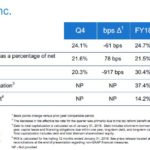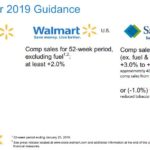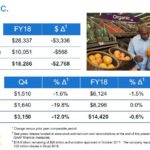Contents
 Summary
Summary
- WMT reported FY2018 results February 20, 2018 and its stock price dropped ~10%; results were solid but investors had bid up WMT’s stock price to an unreasonable valuation.
- It continues to generate strong FCF and management is deploying its resources so that WMT can adapt to the evolving retail landscape.
- WMT announced a ~2% dividend increase and also has a $20B share buyback program which was announced in October 2017.
- If you view WMT from a long-term investment perspective the recent pullback presents an attractive buying opportunity.
Introduction
On February 20, 2018, Walmart Inc. (NYSE: WMT) released its Q4 and FY2018 results and provided guidance for FY2019.
Results failed to impress the investment community and WMT’s stock plunged ~$10.70/share after the earnings release. Most investors will be disappointed with the drop. If you, however, are of the opinion that WMT’s management is sufficiently astute to navigate WMT through the evolving retail environment thereby enabling WMT to maintain its status as one of the world’s largest retailers for several years to come, you should welcome the price drop.
In my opinion, this pullback is because investors have overlooked the underlying fundamentals. I view much of the increase in WMT’s stock price over the last few months as a result of many investors ‘not wanting to miss the party’.
Impact of the Tax Cuts and Jobs Act (TCJ) on WMT
WMT issued FY2019 guidance in its October 2017 meeting for the investment community. As a result of the recent tax reform, however, WMT has subsequently reassessed potential opportunities to accelerate investments.
Based on its expectations related to tax reform, WMT anticipates its FY2019 effective tax rate will be 24% - 26% versus previous guidance prior to tax reform of 32.5%; WMT’s global blended rate is higher than the new U.S. federal rate due to state taxes and taxes it pays outside of the U.S..
In addition to the income statement benefit from a lower U.S. tax rate, WMT expects an additional cash tax benefit due primarily to accelerated depreciation. Including all aspects of tax reform, WMT expects a ~$2B cash benefit for FY2019.
Q4 and FY2018 Financial Results and FY2019 Outlook
WMT’s February 20, 2018 Earnings Release can be found here.

 Source: WMT Q4 FY2018 Earnings Release Presentation – February 20, 2018
Source: WMT Q4 FY2018 Earnings Release Presentation – February 20, 2018
In a nutshell WMT achieved the following in FY2018:
- Total revenue surpassed $500B for the first time. This was a ~$15.1B increase from FY2017;
- WMT U.S. comp sales grew ~2.1% which was the highest level of growth since FY2009;
- WMT U.S. eCommerce sales reached $11.5B representing a ~44% growth;
- Adjusted EPS increased ~2%;
- Operating cash flow was ~$28.3B;
- WMT distributed ~$14.4B to shareholders in the form of dividends and share repurchases.
At WMT’s October 10, 2017, 2017 Investment Community Meeting, management reconfirmed its FY2018 adjusted EPS outlook of $4.30 - $4.40 and indicated it expected FY2019’s adjusted EPS to increase ~5%.
WMT has now reported FY2018 adjusted EPS of $4.42 and expectations are for FY2019 EPS of $4.75 - $5.00. This is a 7% - 13% increase versus the previously announced ~5% increase.

 Source: WMT Q4 FY2018 Earnings Release Presentation – February 20, 2018
Source: WMT Q4 FY2018 Earnings Release Presentation – February 20, 2018
WMT expects sales growth at the lower end of the 3% - 4% range when Yihaodian and Suburbia are excluded. This, however, still represents ~$15B of growth.
On the e-commerce front, management expects Walmart U.S. growth to slow a little to overlap the Jet acquisition. Q4 sales growth was 23% percent versus 50% in Q3. The majority of this slowdown was expected but a smaller portion of the slowdown was unexpected. Management indicates WMT experienced some operational challenges that negatively impacted growth. Overall, however, WMT finished the year with eCommerce sales growth of ~44% and eCommerce growth of 40% is projected for FY2019.
This projected 40% growth includes all web-initiated transactions, including those through Walmart.com, Ship to Home, Ship to Store, PickUp Today and Online Grocery, as well as transactions through Jet.com and the other sites in WMT’s family of brands.
On a global basis, e-commerce sales include SamsClub.com and the e-commerce operations in WMT’s international markets. This total is expected to be ~$17.5B in FY2019; this figure is lowered by WMT’s divestiture of Yihaodia as WMT is now partnering with JD.com in China.
Credit Ratings
Moody’s rates WMT’s senior unsecured debt Aa2 while Standard & Poor’s rates it AA. Both ratings are at the mid-point of the ‘High Grade’ scale. These ratings are 2 notches below the coveted AAA credit rating.
Free Cash Flow (FCF)
FCF (a non GAAP measure) as reported by WMT amounted to $18.286B in FY2018. This compares with $21.054BB in FY2017, $15.912B in FY2016, and $16.39B in FY2015.
 Source: WMT Q4 FY2018 Earnings Release Presentation – February 20, 2018
Source: WMT Q4 FY2018 Earnings Release Presentation – February 20, 2018
Valuation
FY2018 Diluted EPS (GAAP) and adjusted Diluted EPS (Non GAAP) amounted to $3.28 and $4.42 respectively. Management has forecast 7% - 13% growth from the $4.42 FY2018 adjusted Diluted EPS thus resulting in a range of $4.75 - $5.00 for FY2018.
The ~10% drop in WMT’s stock price on February 20, 2018 subsequent to the FY2018 earnings release now makes WMT shares far more attractive than when the stock was at its recent high of ~$110.
WMT closed at ~$94 on February 20, 2018 so based on FY2019’s adjusted EPS range, WMT is currently trading at an adjusted PE of ~19.
I now view WMT as being reasonably valued.
Dividend, Dividend Yield, and Dividend Payout Ratio
WMT’s dividend and stock split history can be found here.
In FY2018, WMT returned $14.4B to shareholders via $6.1B in dividends ($6.216B in FY2017 and $6.3B in FY2016) and $8.3B in share repurchases ($8.298B in FY2017 and $4.1B in FY2016).
On February 20, 2018, WMT’s Board of Directors approved the 45th consecutive annual dividend increase. The new $2.08/share annual cash dividend ($0.52/share/quarter) for FY2019 is a 2% increase from FY2017’s annual $2.04/share cash dividend.
With WMT’s stock now trading at ~$94, the forward dividend yield is ~2.2%.
FY2018’s $2.04 annual dividend is ~62% of WMT’s FY2018 Diluted EPS (GAAP) of $3.28/share but is only ~46% of its $4.42 adjusted Diluted EPS (Non GAAP). The new $2.08 annual dividend will represent a dividend payout ratio of ~41.6% - ~43.8% based on the projected adjusted Diluted EPS range of $4.75 - $5.00 for FY2019.
WMT continues to reduce its share count with the basic weighted-average common shares outstanding being ~3 million in FY2018 and ~3.1 million in FY2017 and the diluted weighted-average common shares outstanding being ~3 million in FY2018 and ~3.11 million in FY2017.
WMT is highly committed to rewarding shareholders through share buybacks and announced a $20B share repurchase program in October 2017.
Final Thoughts
I think investors bid up WMT’s stock price to an unrealistic level in late 2017 and early 2018. The recent ~$10 pullback in WMT’s stock price has now brought the stock price back to a more reasonable valuation level.
WMT is certainly not a stock for dividend yield hungry investors but steady annual dividend growth coupled with share buybacks will continue to reward shareholders who view WMT as a long-term investment.
I fully intend to acquire additional WMT shares within the next 72 hours.
I hope you enjoyed this post and I wish you much success on your journey to financial freedom.
Thanks for reading!
Note: I sincerely appreciate the time you took to read this article. Please send any feedback, corrections, or questions to [email protected]
Disclaimer: I have no knowledge of your individual circumstances and am not providing individualized advice or recommendations. I encourage you not to make any investment decision without conducting your own research and due diligence. You should also consult your financial advisor about your specific situation.
Disclosure: I am long WMT.
I wrote this article myself and it expresses my own opinions. I am not receiving compensation for it and have no business relationship with any company whose stock is mentioned in this article.

